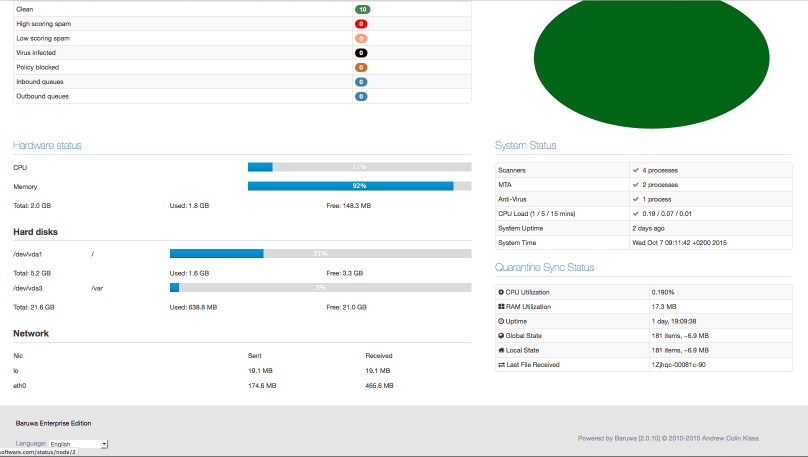Taking a look at upcoming Baruwa Enterprise Edition release 2.1.0
October 03, 2015 at 09:00 AM | categories: Baruwa, Releases, Baruwa Enterprise, BaruwaOS, 2.1.0, Baruwa Enterprise EditionWe will soon release Baruwa Enterprise Edition version 2.1.0 as part of BaruwaOS 6.7.2
This update has greatly improved the clustering functionality. This release introduces the ability to setup shared a quarantine without using a shared storage system. This functionality is implemented using a file syncronization system that ensures that the quarantine is in sync across all the nodes in a cluster.
Quarantine syncronization
From version 2.1.0 Baruwa now has built in shared quarantine syncronization without a shared storage system. Quarantined messages are now syncronized between all the cluster nodes. This eliminates the need for a shared filesystem as was previously required. Because messages are syncronized between the cluster members any of the cluster members can process requests to release, learn delete quarantined messages. Users are able to access messages even when the specific host that processed the message via SMTP is not accessible.
When you select use shared quarantine in baruwa-setup, built in syncronization is automatically enabled, if you wish to use a shared filesystem on Baruwa versions >= 2.1.0 you need to overide the built in syncronization by creating the file /etc/baruwa/sync.disable. You can do that by running the following command:
touch /etc/baruwa/sync.disable
In order for the cluster hosts to be able to locate each other you need to add them as nodes under Settings and provide the correct IP address. The cluster nodes perform syncronization on port TCP 1027. If some of your cluster nodes are behind a port forwarded firewall, you need to forward port 1027 to the actual cluster node. If you have multiple nodes behind the same firewall you should use different ports to portforward to 1027 on each internal server. You then need to modify the scanning node under settings and set the port to the port you have configured for this specific server on the firewall.
Status
The syncronization status of each node is available in the web interface.

Note
Note this is a technology preview and could still be rough around the edges.











